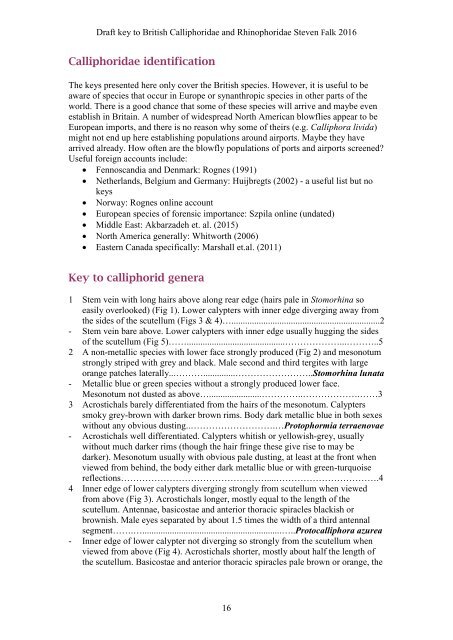BRITISH BLOWFLIES (CALLIPHORIDAE) AND WOODLOUSE FLIES (RHINOPHORIDAE)
4cmTmdCuA
4cmTmdCuA
You also want an ePaper? Increase the reach of your titles
YUMPU automatically turns print PDFs into web optimized ePapers that Google loves.
Draft key to British Calliphoridae and Rhinophoridae Steven Falk 2016<br />
Calliphoridae identification<br />
The keys presented here only cover the British species. However, it is useful to be<br />
aware of species that occur in Europe or synanthropic species in other parts of the<br />
world. There is a good chance that some of these species will arrive and maybe even<br />
establish in Britain. A number of widespread North American blowflies appear to be<br />
European imports, and there is no reason why some of theirs (e.g. Calliphora livida)<br />
might not end up here establishing populations around airports. Maybe they have<br />
arrived already. How often are the blowfly populations of ports and airports screened?<br />
Useful foreign accounts include:<br />
Fennoscandia and Denmark: Rognes (1991)<br />
Netherlands, Belgium and Germany: Huijbregts (2002) - a useful list but no<br />
keys<br />
Norway: Rognes online account<br />
European species of forensic importance: Szpila online (undated)<br />
Middle East: Akbarzadeh et. al. (2015)<br />
North America generally: Whitworth (2006)<br />
Eastern Canada specifically: Marshall et.al. (2011)<br />
Key to calliphorid genera<br />
1 Stem vein with long hairs above along rear edge (hairs pale in Stomorhina so<br />
easily overlooked) (Fig 1). Lower calypters with inner edge diverging away from<br />
the sides of the scutellum (Figs 3 & 4)….................................................................2<br />
- Stem vein bare above. Lower calypters with inner edge usually hugging the sides<br />
of the scutellum (Fig 5)……...........................................………………...………..5<br />
2 A non-metallic species with lower face strongly produced (Fig 2) and mesonotum<br />
strongly striped with grey and black. Male second and third tergites with large<br />
orange patches laterally...………..............……………………..Stomorhina lunata<br />
- Metallic blue or green species without a strongly produced lower face.<br />
Mesonotum not dusted as above….......................…………..……………….……3<br />
3 Acrostichals barely differentiated from the hairs of the mesonotum. Calypters<br />
smoky grey-brown with darker brown rims. Body dark metallic blue in both sexes<br />
without any obvious dusting..……………………….…Protophormia terraenovae<br />
- Acrostichals well differentiated. Calypters whitish or yellowish-grey, usually<br />
without much darker rims (though the hair fringe these give rise to may be<br />
darker). Mesonotum usually with obvious pale dusting, at least at the front when<br />
viewed from behind, the body either dark metallic blue or with green-turquoise<br />
reflections…………………………………………....…………………………….4<br />
4 Inner edge of lower calypters diverging strongly from scutellum when viewed<br />
from above (Fig 3). Acrostichals longer, mostly equal to the length of the<br />
scutellum. Antennae, basicostae and anterior thoracic spiracles blackish or<br />
brownish. Male eyes separated by about 1.5 times the width of a third antennal<br />
segment…….….............................................................…..Protocalliphora azurea<br />
- Inner edge of lower calypter not diverging so strongly from the scutellum when<br />
viewed from above (Fig 4). Acrostichals shorter, mostly about half the length of<br />
the scutellum. Basicostae and anterior thoracic spiracles pale brown or orange, the<br />
16


